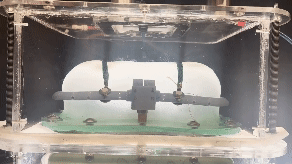Graduate Thesis:
Respiratory Simulator Bench Top Model
Therapeutic Technology Design and Development Lab
Diaphragm dysfunction can lead to respiratory difficulties and failure, requiring interventions like positive pressure ventilation that forces air into the lungs. Such interventions can interfere or hinder a patient’s quality of life, making activities like speech and swallowing extremely difficult. Surgically implanted soft robotic actuators have been explored to mechanically support diaphragmatic motion in a patient that has lost function of such an important muscle.
For my graduate research, I developed a respiratory simulator that would be used for the verification of new iterations of soft robotic assistive devices by replicating the physiological biomechanics of the respiratory system. Design requirements were developed based on a past iteration of the simulator, information gathered from previous in vivo validation and background research into human respiratory anatomy.
After multiple iterations, the simulator was capable of recreating and maintaining physiological pressures in the major cavities of the body while performing active diaphragmatic motion. The modular design allowed for rapid testing of different types of diaphragmatic assist actuators, patient conditions and breathing patterns. The simulator also successfully verified that the assistive devices could recreate physiologically relevant pressure drops.
This respiratory simulator lays the groundwork for the rapid development of implantable assistive breathing devices that serve as a new ventilation option that will liberate the airways and not sacrifice quality of life.
 |  |  |  |
|---|---|---|---|
 |  |
